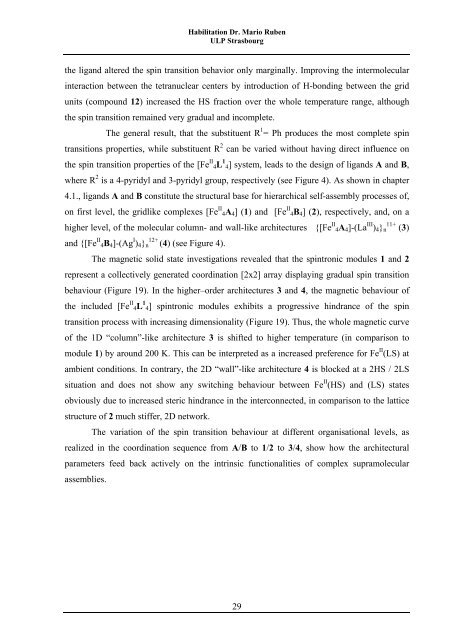Functional (Supra)Molecular Nanostructures - ruben-group
Functional (Supra)Molecular Nanostructures - ruben-group
Functional (Supra)Molecular Nanostructures - ruben-group
Create successful ePaper yourself
Turn your PDF publications into a flip-book with our unique Google optimized e-Paper software.
Habilitation Dr. Mario Ruben<br />
ULP Strasbourg<br />
the ligand altered the spin transition behavior only marginally. Improving the intermolecular<br />
interaction between the tetranuclear centers by introduction of H-bonding between the grid<br />
units (compound 12) increased the HS fraction over the whole temperature range, although<br />
the spin transition remained very gradual and incomplete.<br />
The general result, that the substituent R 1 = Ph produces the most complete spin<br />
transitions properties, while substituent R 2 can be varied without having direct influence on<br />
the spin transition properties of the [Fe II 4L 1 4] system, leads to the design of ligands A and B,<br />
where R 2 is a 4-pyridyl and 3-pyridyl <strong>group</strong>, respectively (see Figure 4). As shown in chapter<br />
4.1., ligands A and B constitute the structural base for hierarchical self-assembly processes of,<br />
on first level, the gridlike complexes [Fe II 4A4] (1) and [Fe II 4B4] (2), respectively, and, on a<br />
higher level, of the molecular column- and wall-like architectures {[Fe II 4A4]-(La III )4}n 11+ (3)<br />
and {[Fe II 4B4]-(Ag I )4}n 12+ (4) (see Figure 4).<br />
The magnetic solid state investigations revealed that the spintronic modules 1 and 2<br />
represent a collectively generated coordination [2x2] array displaying gradual spin transition<br />
behaviour (Figure 19). In the higher–order architectures 3 and 4, the magnetic behaviour of<br />
the included [Fe II 4L 1 4] spintronic modules exhibits a progressive hindrance of the spin<br />
transition process with increasing dimensionality (Figure 19). Thus, the whole magnetic curve<br />
of the 1D “column”-like architecture 3 is shifted to higher temperature (in comparison to<br />
module 1) by around 200 K. This can be interpreted as a increased preference for Fe II (LS) at<br />
ambient conditions. In contrary, the 2D “wall”-like architecture 4 is blocked at a 2HS / 2LS<br />
situation and does not show any switching behaviour between Fe II (HS) and (LS) states<br />
obviously due to increased steric hindrance in the interconnected, in comparison to the lattice<br />
structure of 2 much stiffer, 2D network.<br />
The variation of the spin transition behaviour at different organisational levels, as<br />
realized in the coordination sequence from A/B to 1/2 to 3/4, show how the architectural<br />
parameters feed back actively on the intrinsic functionalities of complex supramolecular<br />
assemblies.<br />
29


